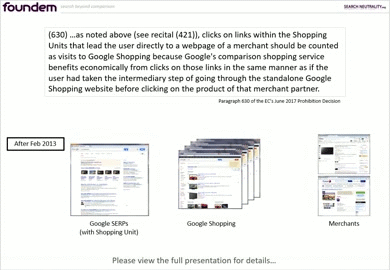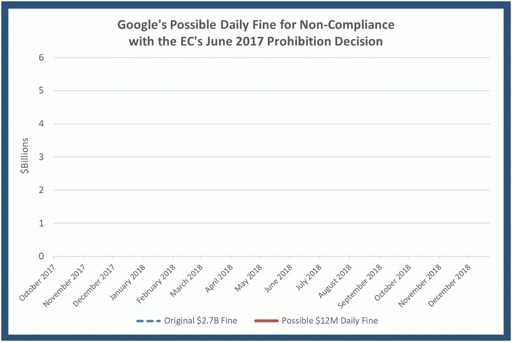Our November 3rd 2009 Competition Complaint triggered the EC’s and US FTC’s antitrust investigations into Google’s search manipulation practices. As we approach the 10-year anniversary of our Complaint, and with Commissioner Vestager set to embark on a welcome second consecutive term as Competition Commissioner, it seems like a good time to reflect on what has been achieved, and, more importantly, what remains to be achieved.
Having issued three landmark Prohibition Decisions against Google during her first term (totalling nearly $10 billion in fines), it is now critical that Commissioner Vestager uses her second term to enforce those Decisions—holding Google to effective and compliant remedies that restore the level playing field Google has spent the last decade quietly tilting in its favour.
Our November 2017 and April 2018 online presentations demonstrated that Google’s CSS Auction, which Google introduced as a “Compliance Mechanism”, falls far short of the equal treatment standard mandated by the EC’s June 2017 Prohibition Decision. Today, we are publishing a presentation that demonstrates that this auction is, in fact, a thinly-veiled continuation of exactly the same anti-competitive conduct already defined and prohibited by the Decision:

Google could have interpreted the Commission’s June 2017 demand for equal treatment within its search result pages as a call for a return to the relevance-based search results Google built its reputation and monopoly on. After all, that is what most of Google’s users wrongly assume they are still getting when they use Google. But, instead, Google has thumbed its nose at both the Commission and its own users by misinterpreting the Commission’s call for equal access to relevance-based search results as a demand for unequal, and positively harmful, access to pay-for-placement advertisements.
And, this isn’t the first time Google has tried this ruse. Google’s three previous auction-based “remedy” proposals were all resoundingly rejected under Commissioner Almunia, precisely because they were auction-based.[1] As we explained in our earlier presentations, the primary difference between Google’s current auction-based offering and its three previous versions is that, in the current version, Google’s own service also “participates” in the auction. But this participation is a facade: in stark contrast to rivals’ bids, which deprive rivals of nearly all of their profits (and, with it, their ability and incentive to innovate and grow), Google’s own “bids” cost Google nothing. As we explained, that’s because Google’s bids aren’t real. They are, literally and figuratively, monopoly money—meaningless internal accounting, where every transaction recorded as a “cost” has an equal and corresponding “credit”.
Google’s CSS Auction presents users with pay-for-placement advertisements from the highest bidders, instead of the relevance-based search results they almost certainly came to Google for. Unsurprisingly, whenever relevance-based search results are replaced with ads—where the amount advertisers are willing to pay is often a decisive factor in determining which ads are shown—this inevitably leads to users paying higher prices for products and services than they would otherwise.[2]
As mentioned above, the presentation we are publishing today demonstrates that Google’s CSS Auction is not only the polar opposite of equal treatment, it is, in fact, a direct continuation of the same anti-competitive conduct already identified and prohibited by the EC’s June 2017 Decision.
As our presentation explains, in February 2013, Google introduced a fundamental change to the self-preferencing half of the anti-competitive search manipulation practices the EC and FTC were actively investigating. This change (from prominently positioned links to Google’s CSS to prominently positioned pay-for-placement ads lifted directly from Google’s CSS) made no difference to the traffic Google was anti-competitively diverting away from competing services, but it did make a difference to how and where that traffic was diverted.
Google’s adoption of a pay-for-placement model represented a substantial departure from several of Google’s founding principles, including the “clear, large wall between the objective search results and the ads”,[3] and the promise that, “at Google, search results cannot be bought or paid for”.[4] Indeed, this change prompted headlines such as “How Evil Are Google’s New Paid Shopping Search Results?”[5] and “Google product search results get a commercial bias”.[6]
Google didn’t just make this change during the EC’s investigation; it did so in the midst of what were supposed to be good faith settlement negotiations. This is particularly troubling, because we now know that one of the ways Google persuaded the EC to explore the possibility of a settlement in the first place was by dangling a remedy proposal that guaranteed deep-links to rival services alongside Google’s own, with no mention or hint of any payment or auction. On the contrary, Google’s June 2012 written outline of this proposal made clear that it would select and place three rival services based solely on their algorithmically determined relevance to the user’s search query. For example, the following is an extract from Google’s June 2012 proposal[7] (which, to the best of our knowledge, has not previously been publicly discussed):
“Google proposes to display up to three, algorithmically selected links to rival “vertical” search sites within Google’s Product and Local Universal Results…These links will lead, to the extent possible, directly to result pages of the alternative vertical search site for the query that the user entered on Google…for each relevant query, Google will algorithmically select for display three qualifying sites based on their Web Search rank for that query…
Because rival sites will be selected algorithmically different sites can appear for different types of queries…and new sites may surface as they gain in relevance.”
It seems that Google’s February 2013 transition to a pay-for-placement model might have been the sole basis for the bait-and-switch Google then pulled; by the time Google’s official proposals were submitted in May 2013, the promised links to rival services had morphed from helpful, relevance-based search results, into positively harmful, pay-for-placement ads via an auction.
Not only did this transition pave the way for several years of futile negotiations around variations on an auction-based mechanism that never had any prospect of delivering a viable remedy, it also presented the Commission with a challenge: How to deal with this change in Google’s anti-competitive conduct—from the straightforward traffic-diversion of Product Universals and penalties, to the less straightforward, but even more harmful, traffic-and-revenue-diversion of Shopping Units and penalties?
As we explain in our presentation, the solution was to follow the money. The finding at paragraph 630 of the Prohibition Decision allows Google’s transition from link-based traffic-diversion to ad-based revenue-and-traffic-diversion to be both identified and empirically quantified. And, it is this same pivotal finding that allows us to demonstrate that Google’s so-called “Compliance Mechanism” is an empirically quantifiable continuation of exactly the same illegal conduct already identified by the Decision.
Finally, with U.S. regulators now launching fresh probes into Google’s anti-competitive practices, it is worth noting that Google made exactly the same transition from traffic-diverting Product Universals to traffic-and-revenue-diverting Shopping Units in the U.S. in October 2012. As U.S. regulators look to address the immense escalation in consumer and competitive harm caused by this transition, they will need to follow the EC’s lead. We hope that our presentation, which explains the crucial empirical relationship between the traffic diverted by Product Universals and the traffic/revenue diverted by Shopping Units, might be of some assistance in this regard.
[7] Extracts from Google’s June 30 2012, Annex 1 – Discussion Paper Submitted by Google on The Preliminary Concerns Identified by the EC and Google’s Proposed Solution

